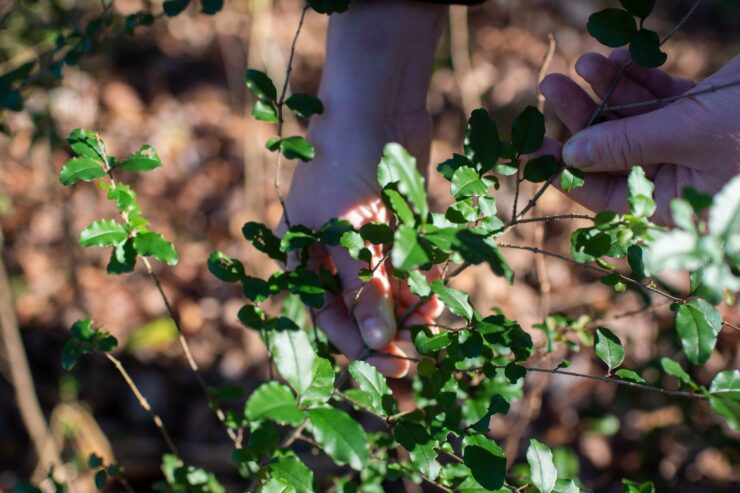Chinese Privet (Ligustrum sinense) is a woody shrub with opposite, simple, entire leaves. About 1 inch in length. Chinese Privet forms a shrub reaching heights of about 15 feet.
Physical Characteristics
Chinese Privet grows as a shrub. It reaches heights between 6 to 12 feet. The leaves are opposite, simple, and oval-shaped. They measure 1 to 2 inches long. The plant produces small, white flowers in late spring. These flowers form in clusters, creating a fragrant and attractive display. The flowers give way to small, dark berries that persist through winter.
Growth and Care
Planting
Plant Chinese Privet in well-drained soil. It prefers full sun but tolerates partial shade. Space the plants 3 to 5 feet apart to allow for proper growth. Water the plants regularly during the first growing season to establish a deep root system.
Maintenance
Prune Chinese Privet regularly to maintain its shape and size. Remove dead or diseased branches. Pruning encourages new growth and helps control the plant’s spread. Fertilize in early spring with a balanced fertilizer to promote healthy growth.
Planting
- Location: Choose a spot with adequate sunlight and well-drained soil.
- Planting: Dig a hole twice the width and depth of the root ball. Place the plant in the hole, backfill with soil, and water thoroughly.
- Spacing: Space plants 3 to 5 feet apart for hedges, or 6 to 8 feet apart for individual specimens.
Maintenance
- Pruning: Prune 2-3 times a year to control size and shape. Prune in late winter or early spring to remove dead or diseased branches and encourage new growth.
- Fertilizing: Apply a slow-release, balanced fertilizer in spring to promote growth and flowering.
- Mulching: Apply a 2-3 inch layer of mulch around the base to conserve moisture, suppress weeds, and regulate soil temperature.
Propagation
- Seeds: Collect seeds from ripe berries in the fall. Clean and dry them before planting in well-draining soil.
- Cuttings: Take 4-6 inch stem cuttings in late summer. Use rooting hormone and plant in a well-draining potting mix. Keep moist and in a bright location out of direct sunlight.
- Layering: Bend a low-growing branch to the ground, cover it with soil, and wait for roots to develop. Cut and transplant once rooted.
Benefits and Uses
- Hedges and Screens: Ideal for creating privacy screens due to its dense foliage.
- Ornamental: Attractive flowers and berries make it a great choice for garden beds and borders.
- Erosion Control: Helps stabilize soil on slopes.
Potential Issues
- Invasiveness: Chinese Privet can be invasive in some regions, spreading rapidly and outcompeting native plants. Regular pruning and removal of seedlings are necessary to control its spread.
- Pests and Diseases: Common issues include scale insects, spider mites, leaf spots, and root rot. Regular monitoring and prompt treatment can keep these problems in check.
Should You Grow Chinese Privet?
Chinese Privet is an excellent choice for those looking for a hardy, low-maintenance shrub. It offers year-round interest and serves various practical purposes in landscaping. However, its potential invasiveness means it requires regular maintenance to prevent it from becoming a problem.
FAQs
Is Chinese Privet suitable for small gardens?
Yes, select compact varieties like ‘Swift Creek’ for small spaces.
How often should I prune Chinese Privet?
Prune at least once a year to maintain shape and control growth. More frequent pruning may be necessary in some cases.
Can Chinese Privet grow in shade?
It prefers full sun but tolerates partial shade. Growth may be less vigorous in shaded areas.
How do I control the spread of Chinese Privet?
Regular pruning and removal of unwanted seedlings help manage its spread. Consider planting in contained areas to limit its invasiveness.
What wildlife benefits from Chinese Privet?
Bees and butterflies are attracted to its flowers. Birds feed on its berries during winter.
Are there any pests that affect Chinese Privet?
Scale insects and fungal diseases can affect Chinese Privet. Regular monitoring and prompt treatment are necessary.
Final Thoughts
If you need a low-maintenance plant for privacy or erosion control, Chinese Privet can be a good choice. Just be mindful of its potential to spread aggressively. With proper care, you can enjoy its beauty and practical benefits for many years.

